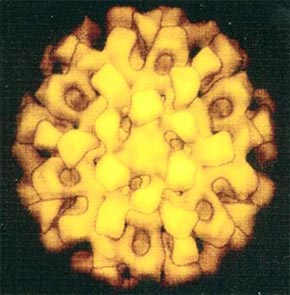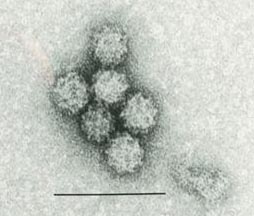|
A virus originating
from the ocean has been found in human blood samples.
by Jen Schripsema
 Courtesy of Alvin Smith
Courtesy of Alvin Smith
Close-up view of the surface of a single vesivirus using cryomicroscopy.
|
|
Oceans cover most of our planet, yet we know very little about marine ecosystems and even less about their pathogens and how they might infect us. When virologist Alvin Smith was working as a veterinarian for the U.S. Navy, he found that one marine virus called Vesivirus was causing a multitude of symptoms in a very wide range of animals - and could also spread from animals to humans. More recently, along with a team of researchers from Oregon State University, Eastern Virginia Medical School and AVI BioPharma, he has been studying how prevalent Vesivirus is in the general human population.
Vesivirus can infect a broad range of species due to an adaptive trait that has developed based on its replication mechanisms. Part of a family of viruses called Calciviruses, its genetic information is coded with RNA, not DNA. RNA replication lacks the proofreading inherent in DNA replication, making it very error-prone. Every virus replicated will have one to ten mistakes in the genetic code. Thus, the children from a single parent will virtually all be unique variants.
Although Vesivirus is present in the ocean, it can easily get to the surface. Much like the spray that comes off a freshly poured glass of soda, it can become airborne by erupting in bubbles at the surface of the water. "If you think about it, the ocean is a much easier place for a virus to get around anyway," says Smith. "When the viruses are shed, they're in basically a big bag of saline, so they can move around pretty freely and don't decay nearly as rapidly as they might on land."
Smith's theory was that many people could be unknowingly infected by the virus. It does not have a specific set of symptoms and can sometimes manifest itself simply as a blister - as exemplified by two scientists
a few years ago who contracted the virus, one in the lab and one by working with marine mammals in the field. "If you don't know it's there, and you don't know to test for it, then it simply doesn't exist," says Smith.
To test how widespread the virus really is, the researchers decided to examine many samples of human blood. They obtained over 700 blood samples from a laboratory processing blood donations intended for transfusion - and looked for the presence of Vesivirus as well as for antibodies to Vesivirus which would indicate a previous infection.
 Courtesy of Alvin Smith
Courtesy of Alvin Smith
This cluster
of six Vesiviruses, using negative stain electron microscopy,
shows their typical shape.
|
The results showed an interesting correlation
with liver damage. Among normal blood donations, 12% had antibodies
to the virus but in donors with liver damage, 21% had antibodies.
Based on this preliminary data, the researchers obtained blood samples
from patients with clinical hepatitis, or inflammation of the liver,
and found that 29% of those samples had antibodies. Finally, in
people who developed hepatitis from an unknown cause after being
transfused - 47% had antibodies to Vesivirus.
Further testing that looked for the
presence of the actual virus also showed a higher proportion of
infections among people with liver damage. Eleven percent of people
with liver damage had the virus, compared to only 5% for normal
blood donors.
Although this study doesn't prove that Vesivirus infection causes hepatitis in humans, Smith says that there is no reason to believe that it doesn't. He is currently working on strengthening the evidence of a link between Vesivirus and hepatitis so he can push for Vesivirus screening of the blood supply.
Environmental exposure may
put some people at risk of contracting Vesivirus, and it is always
wise to keep a safe distance from sickly-looking animals, but researchers
believe the biggest danger is probably contaminated meat, seafood,
or drinking water. Smith advises against eating undercooked or raw
seafood.
For those who are infected, biotech company AVI BioPharma is investigating the use of their proprietary NeuGene antisense compound as an anti-viral treatment for Vesivirus. The technology uses a synthetic compound that binds closely with points along the code of the RNA sequence that tell the virus to begin replication. "It's like blocking a zipper," says Smith.
NeuGene drugs developed using this technology successfully stopped an outbreak of fatal Calicivirus in cats. The company is developing several other drug candidates for treatment of other RNA viruses including hepatitis C, influenza, and West Nile virus. This technology may signal the beginning of the end of the "wait and see" approach to viral infection treatment.
For more information:
MedScape - Marine Virus May Account for Some Unexplained Human Illnesses
http://www.medscape.com/viewarticle/533457
Eastern Virginia Medical School - Virus linked to hepatitis may have ocean origin
http://www.evms.edu/about/news/2006-03-27-matson-hepatitis.html
|
